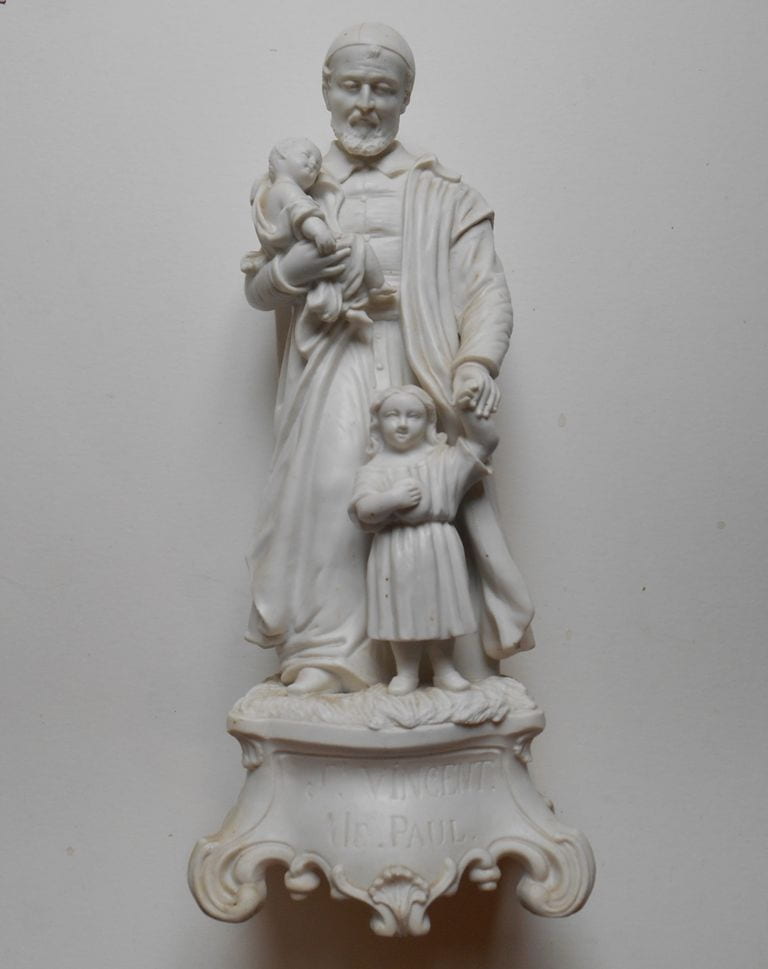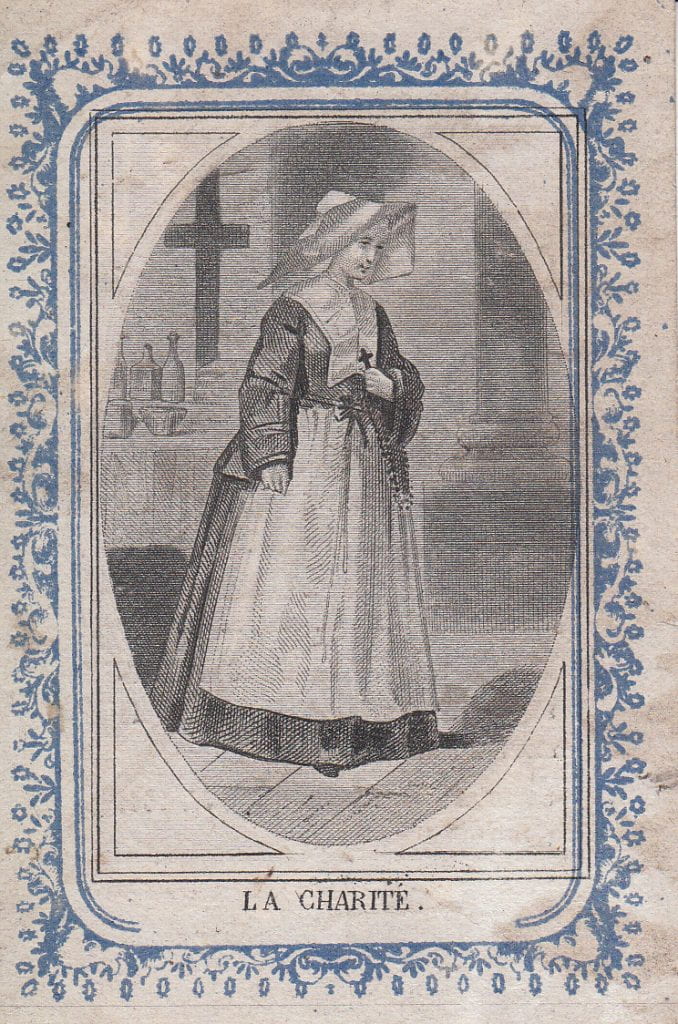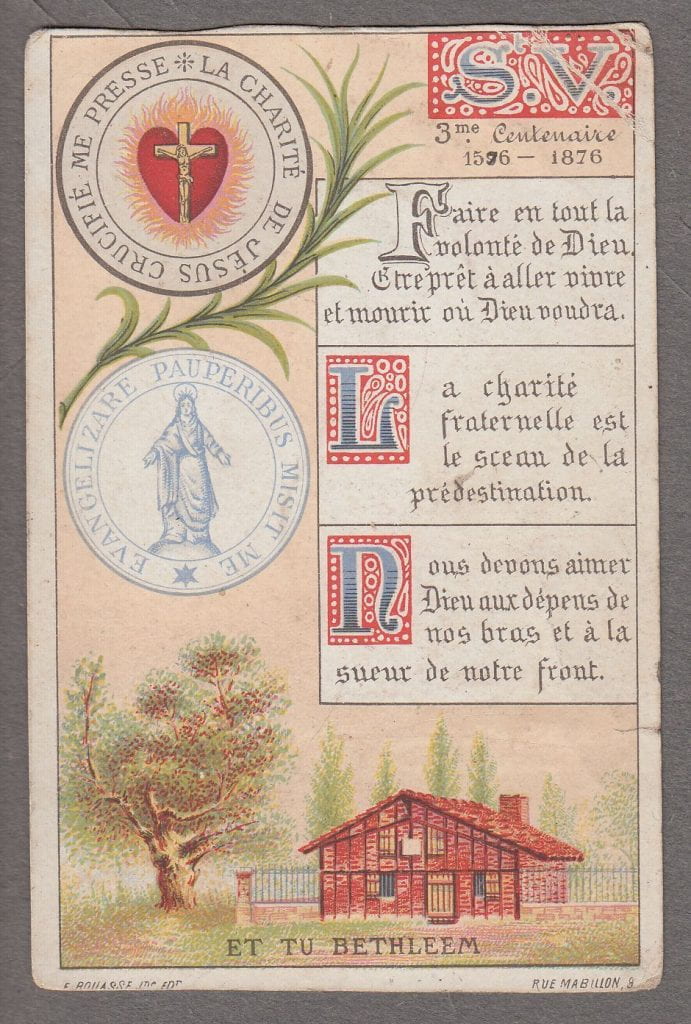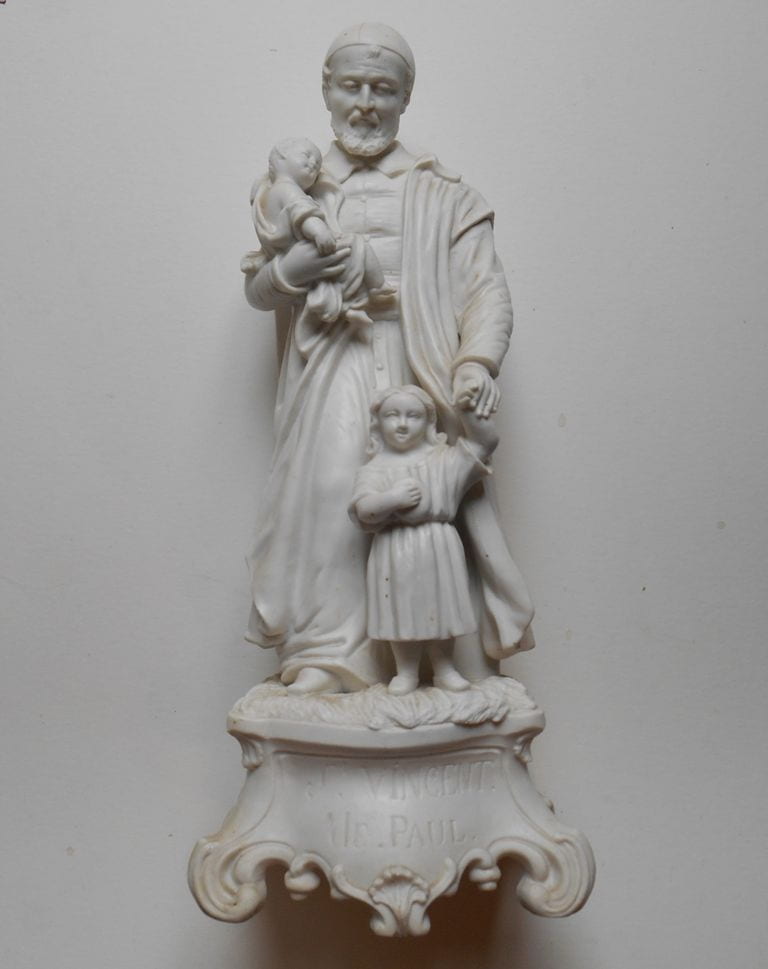The Vincentiana Collection in the Archives and Special Collections Department of DePaul University’s Richardson Library has recently purchased this early 19th century color lithograph of St. Vincent. The legend at the bottom reads: “St. Vincent de Paul. Founder of the priests of the Mission and of the Sisters of Charity, and of the Pitie, Bicetre, Salpetriere and Foundling hospitals. Born in 1576. Died in 1660. Dedicated to the Maternity Society.
archives
Newsnote: “Vincentiana Purchase of the Week” Daughter of Charity = Icon of Charity
In the mid-19th century Jean-Baptiste Etienne, C.M., the superior general of the Daughters of Charity (1843-1874) was determined that the figure of the Sister of Charity would become the general symbol for all Catholic charity. This mid-19th century holy card depicts the accomplishment of this goal. This card was recently purchased for the Vincentiana Collection at Archives and Special Collections, DePaul University, Chicago, Illinois. This collection is the largest in the world.
Newsnote: “Vincent de Paul. Un saint au Grand Siecle.”
Petit paysan des Landes devenu prêtre, nommé précepteur dans l’illustre famille de Gondi après diverses aventures, Vincent de Paul, né en 1581, découvre à trente-six ans la vocation de sa vie : servir les pauvres. Aumônier général des galères du roi à partir de 1618, il fonde en 1625 la congrégation de la Mission, afin d’évangéliser et soigner le peuple des campagnes, et former des prêtres pour cette tâche. En 1632, il se voit offrir avec sa communauté le prieuré de Saint-Lazare à Paris. Les lazaristes étaient nés. Leur ordre allait devenir un refuge pour des milliers de démunis et un centre de rayonnement spirituel considérable.
Peu à peu, Vincent de Paul s’affirme comme la conscience de son temps. Avec Louise de Marillac, supérieure des Filles de la Charité, il suscite l’engagement et la générosité des femmes de la haute société, lutte sur le terrain contre les horreurs de la guerre de Trente Ans, institue à Paris l’oeuvre des Enfants trouvés. Par sa présence, de 1643 à 1652, au Conseil de conscience de la reine Anne d’Autriche, celui qui fait jeu égal avec les grandes figures de la Contre-Réforme catholique, François de Sales, Bérulle, Olier, influera aussi sur les affaires de l’Etat et s’engagera contre le jansénisme. Les années 1650 le voient jouer un rôle décisif dans le développement des missions étrangères. Il meurt en 1660 et sera canonisé moins d’un siècle plus tard.
Homme de prière, homme d’action, meneur d’hommes, témoin auprès des grands des exigences de la conscience, l’humble paysan gascon est devenu une grande figure de notre histoire.
Newsnote: Vincentiana Purchase of the Week “Vincent’s birth centennial (corrected) 1576-1876
In 1981 the Vincentian family celebrated the 400th anniversary of the birth of Vincent de Paul. The 1581 date resulted from the definitive refutation of the previous date of 1576. The three hundredth anniversary had been celebrated in 1876 as illustrated by this new commemorative card recently purchased for the Vincentiana collections at the Archives and Special Collections of DePaul University.
Writing with a Mission. The correspondence of Vincentian missionaries with Paris and Rome, 1645-1689
In September 2014 I completed my master thesis entitled “Writing with a Mission. The correspondence of Vincentian missionaries with Paris and Rome, 1645-1689”. While collaborating on an online collection of documents regarding the Congregation of the Mission that can be found in the Vatican Archives (especially the Propaganda Fide branch), I became interested in understanding better how the correspondence that I was looking at functioned in practice. Moreover, I was curious to understand how the recipients of the letters, i.e. Vincent de Paul himself and the cardinals of Propaganda Fide in Rome, tried to assess their trustworthiness. The aim of my thesis project therefore was to understand how the practical aspects of correspondence, as well as the dynamic of trust and mistrust influenced the communication between the Vincentian missionaries in Scotland and North Africa with their superiors in Paris and Rome in the seventeenth century.
I discovered that correspondence was the principal way to exchange material and spiritual assistance in return for obedience, information and prayers. Since the missionaries themselves were the main source of information on the mission, to understand whether the requested help was really needed, the superiors and prelates needed to assess the trustworthiness of the writers. The exchange was immediately hampered when trusted lacked. Where this was not the case, major obstacles for effective communication could be the complexity of sending letters over large distances. Both the time it took for a letter to arrive and the danger that it would be lost or intercepted negatively influenced the efficacy of communication. An important way to limit these problems was to rely on a complex network of intermediaries, such as the nuncios, procurators and vicars, who could function as trustworthy substitutes nearer to the recipient of a letter.
When a message would arrive, the effectiveness of correspondence depended on the writing strategies used. The prelates in Rome, the superiors and the Vincentian missionaries all wrote with a mission: they wrote to convince ‘the other side’. Rhetoric in the Vincentian correspondence was always both an expression of the opinion and needs of the missionary, and a (conscious or unconscious) response to what was expected ‘from above’. Writing strategies included keeping silent about certain things that might compromise one’s trustworthiness, and telling those stories that the writer believed might enhance it. Using recognizable commonplaces, quantification of success and a well thought-out sequence of a letter would also contribute to the effectiveness of writing. Although this strategic writing is an important aspect of the correspondence, we should not reduce the missionaries’ aim to merely obtaining things: the Vincentians also wished to simply recount what they retained essential in their experience.
By examining three specific case-studies, I discovered that trustworthiness was an essential, but not self-evident part of communication. It had to be assessed and built up over time. Also the participants in the correspondence did not see it as a finished artifact, but were constantly trying to decide whom to trust. As to the day-to-day practice of letter writing, my research shows that the missionaries consciously chose what to write to whom and what to keep silent about: certain details would enhance the effectiveness of their letters, while other information would only incite mistrust.
In our age of instant communication one easily underestimates the efforts that a seventeenth century missionary had to take to communicate with his superiors from a distance. My findings elucidate how the limitations of correspondence greatly influenced the day-to-day life of the Vincentian missionaries.
Newsnote: Vincentiana Purchase of the Week 3/4/2015 Stills from “Monsieur Vincent.”
The Vincentiana Collection at DePaul University’s Special Collections and Archives has the largest known collection of items associated with the classic 1947 French, black-and-white, movie: “Monsieur Vincent.”
This film-starring Pierre Fresnay as Monsieur Vincent- won the 1947 “Grand Prix du Cinema Francaise.” The DePaul collection includes numerous publicity stills from the movie, (like the one feature








